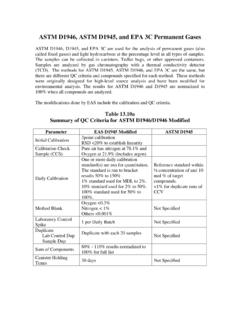Transcription of EPA TO-17 Volatile Organic Compounds - easlab.com
1 EPA TO-17 Volatile Organic Compounds Method TO-17 is used to analyze samples for Volatile Organic Compounds collected on multi-bed sorbent tubes, which are thermally desorbed and cryo-focused on the capillary column and then analyzed by GC/MS. The range of Compounds analyzed by the method depends on the selection of the sorbent cartridge. EAS follows the method recommendation that the calibration and QC criteria for Method TO-17 follow the TO-15 method. The modifications done by EAS include the target list. The method recommends using the Method TO-15 QC criteria. EAS uses the modified TO-15 QC criteria listed in Table Table TO-17 Sorbent Cartridge Selection Guide Tube Name Compounds Packing Desorption Temperature Tenax TA BTEX Diesel Range Organic Tenax TA 300C Carbotrap 300 General VOC Carbopak C Carbopak B Carboseive SIII 325C VOC General VOC Tenax TA Carboxen 1000 Carboseive SIII 325C TO-17 tubes can also be sampled passively using special adapters.
2 The tubes are desorbed and analyzed in the same manner as the normal TO-17 , and the TO-17 QC criteria is used. Table TO-17 Recommended Sampling Times Final Volume Flow Rate Time 500 ml 100 ml/min 5 min 480 ml 1 ml/min 8 hours 720 ml ml/min 24 hours Table TO-17 Summary of QC Criteria for Method TO-17 Parameter EAS TO-15 Modified TO-17 Method BFB Tune Daily (24 hour) 12 hours if Required Daily (24 hour) Tuning Criteria with BFB TO-15 Tune Criteria TO-15 Tune Criteria Initial Calibration Five points minimum See Table 90% Compounds meet criteria Same as TO-15. Either liquid standards or gas phase standards can be used. Calibration Check Sample (CCS) After Initial Calibration Same Percent D as Initial Calibration Same as TO-15 Continuing Calibration Verification (CCV) Daily (24 hours) See Table 90% Compounds meet criteria Internal Standard (IS) Pentafluorobenzene 1,4-Difluorobenzene RT < min daily std.
3 Response 60% to 140% 20 ppbv Introduce gas phase internal standard onto sorbent tube (optional) Surrogate Toluene-d8 70-130% recovery Tube Blank <RL for Tubes from the same media. From client media if supplied Once tubes are analyzed they can be considered clean and can be reused Artifact peaks should be identified in final report. Laboratory Control Spike 1 per Daily Batch 70-130% for LCS list See Table Same as TO-15 Duplicate Lab Control Dup Duplicate Pairs Duplicate Pair with each 20 samples <30% for LCS spike list See Table The precision is tested by using six standard tubes and repeated every 10 series of samples The laboratory control spike (LCS) Compounds are indicated in bold in Table The MDL for ppbV is based on a sample volume of 5L. This is the maximum volume that should be TO-17 Method TO-17 compound List and QC Criteria MDL MDL ICAL/CCV LCS PrecisionComponent ug ppbV %D %R %D Freon 12 <30% 70-130 <30% Chloromethane <30% 70-130 <30% Freon 114 <30% 70-130 <30% Vinyl chloride <30% 70-130 <30% Bromomethane <30% 70-130 <30% Chloroethane <30% 70-130
4 <30% Trichlorofluoromethane <30% 70-130 <30% 1,1-Dichloroethene <30% 70-130 <30% Dichloromethane <30% 70-130 <30% Freon 113 <30% 70-130 <30% 1,1-Dichloroethane <30% 70-130 <30% c-1,2-Dichloroethene <30% 70-130 <30% Chloroform <30% 70-130 <30% 1,2-Dichloroethane <30% 70-130 <30% 1,1,1-Trichloroethane <30% 70-130 <30% Benzene <30% 70-130 <30% Carbon Tetrachloride <30% 70-130 <30% 1,2-Dichloropropane <30% 70-130 <30% Trichloroethene <30% 70-130 <30% c-1,3-Dichloropropene <30% 70-130 <30% t-1,3-Dichloropropene <30% 70-130 <30% 1,1,2-Trichloroethane <30% 70-130 <30% Toluene <30% 70-130 <30% 1.
5 2-Dibromoethane <30% 70-130 <30% Tetrachloroethene <30% 70-130 <30% Chlorobenzene <30% 70-130 <30% Ethylbenzene <30% 70-130 <30% M,p-Xylenes <30% 70-130 <30% Styrene <30% 70-130 <30% o-Xylene <30% 70-130 <30% 1,1,2,2-Tetrachloroethane <30% 70-130 <30% 1,3,5-Trimethylbenzene <30% 70-130 <30% 1,2,4-Trimethylbenzene <30% 70-130 <30% 1,3-Dichlorobenzene <30% 70-130 <30% 1,4-Dichlorobenzene <30% 70-130 <30% 1,2-Dichlorobenzene <30% 70-130 <30% 1,2,4-Trichlorobenzene <30% 70-130 <30% Hexachlorobutadiene <50% 50-150 <50% MDL MDL ICAL/CCV LCS PrecisionComponent ug ppbV %D %R %D TO-15 Compounds 1.
6 3-Butadiene <40% 60-140 <40% 2-Butanone <40% 60-140 <40% Acetone <40% 60-140 <40% Carbon Disulfide <40% 60-140 <40% Bromoform <40% 60-140 <40% 4-Methyl-2-pentanone <40% 60-140 <40% 2-Hexanone <40% 60-140 <40% Bromodichloromethane <40% 60-140 <40% Dibromochloromethane <40% 60-140 <40% Vinyl acetate <40% 60-140 <40% t-1.
7 2-Dichloroethene <40% 60-140 <40% Benzylchloride <50% 50-150 <50% 4-Ethyltoluene <40% 60-140 <40% Methyl t-butyl ether <40% 60-140 <40% Cyclohexane <40% 60-140 <40% 1,4-Dioxane <40% 60-140 <40% Tetrahydrofuran <40% 60-140 <40% Hexane <40% 60-140 <40% Heptane <40% 60-140 <40% 2,2.
8 4-Trimethylpentane <40% 60-140 <40% 3-Chloroprene <40% 60-140 <40% Ethyl-Acetate <40% 60-140 <40% 2-Propanol <40% 60-140 <40% TO-15 8260 Compounds n-Proplylbenzene <40% 60-140 <40% Isopropylbenzene <40% 60-140 <40% 2,2-Dichloropropane <40% 60-140 <40% 1,1,1,2-Tetrachloroethane <40% 60-140 <40% Bromochloromethane <40% 60-140 <40% Octane <40% 60-140 <40% Nonane <40% 60-140 <40% Decane <40% 60-140 <40% 1.
9 1-Dichloropropene <40% 60-140 <40% 1,2,3 Trichloropropane <40% 60-140 <40% 1,3-Dichloropropane <40% 60-140 <40% Dibromomethane <40% 60-140 <40% Methyl methacrylate <40% 60-140 <40% Di-isopropyl ether <40% 60-140 <40% Isobutyl Alcohol <40% 60-140 <40% Ethanol <40% 60-140 <40% MDL MDL ICAL/CCV LCS PrecisionComponent ug ppbV %D %R %D n-Butylbenzene
10 <40% 60-140 <40% sec-Butylbenzene <40% 60-140 <40% tert-butylbenzene <40% 60-140 <40% i-Butylbenzene <40% 60-140 <40% p-Isopropyltoluene <40% 60-140 <40% t-Butanol <40% 60-140 <40% 2-Chlorotoluene <40% 60-140 <40% 4-Chlorotoluene <40% 60-140 <40% Methyl Acrylate <40% 60.
